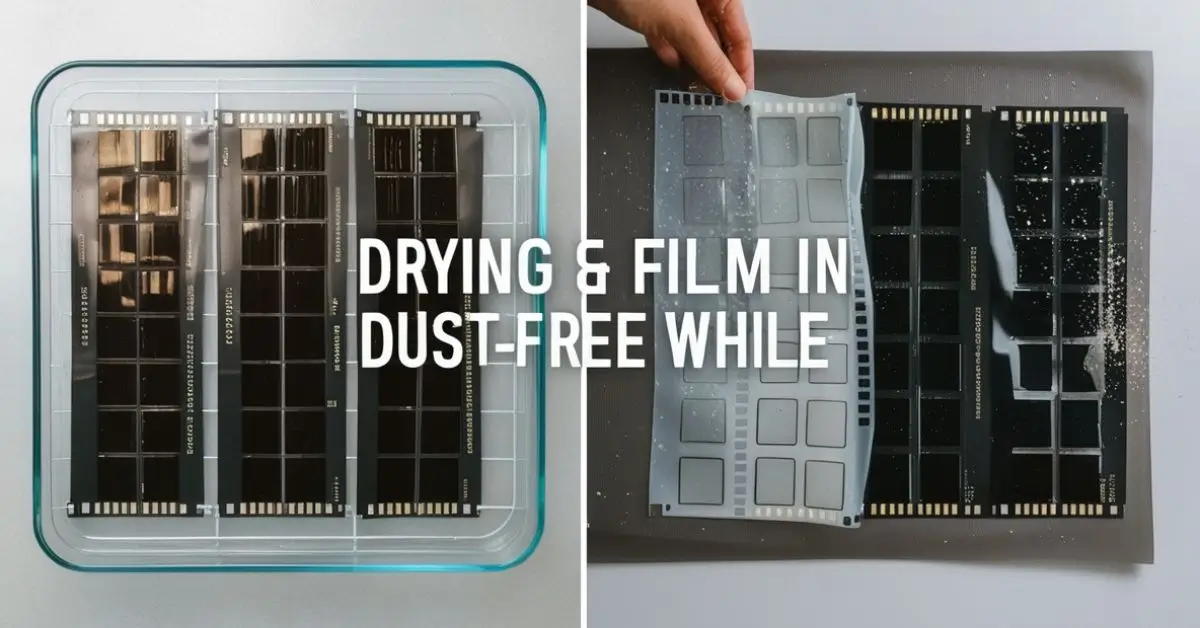Ensuring that your film remains dust-free while drying is a crucial step in the film development process. Dust particles can settle on the film and create unwanted spots or streaks, which may require time-consuming retouching later. Fortunately, there are several practical steps you can take to minimize dust contamination and keep your negatives clean.
This guide will explore the best techniques for drying film in a dust-free environment, from setting up the right space to using specific tools and methods. By following these recommendations, you can achieve pristine, high-quality negatives with minimal effort.
1. Choose the Right Drying Environment
The drying environment plays a significant role in preventing dust accumulation on your film. The goal is to select a location that is clean, enclosed, and has minimal air movement.
Best Locations for Drying Film
- Bathroom: A commonly recommended space due to its relatively high humidity, which helps suppress airborne dust. Running a hot shower for a few minutes before drying the film can settle dust particles.
- Closet: A small, enclosed space with minimal airflow reduces the risk of dust settling on the film.
- Dedicated Film Drying Cabinet: If you have the space and budget, a drying cabinet provides the best results by offering a controlled, dust-free environment.
What to Avoid
- Areas with high foot traffic, such as kitchens or living rooms.
- Places near open windows or vents, as they can introduce airborne dust.
- Basements or garages that might have excess dust and contaminants in the air.
2. Clean the Drying Space Regularly
No matter where you choose to dry your film, regular cleaning is essential. Dust tends to accumulate on surfaces and can become airborne when disturbed.
Cleaning Tips for a Dust-Free Environment
- Wipe down all surfaces with a damp cloth to trap dust rather than just moving it around.
- Use an air purifier or HEPA filter in the drying area to remove dust particles.
- Vacuum the space with a vacuum cleaner that has a HEPA filter to prevent dust from being blown back into the air.
- Avoid shaking clothes, towels, or other fabric materials in the drying area, as they can release dust.
3. Use a Wetting Agent in the Final Rinse
A wetting agent, such as a surfactant, helps water drain evenly off the film and reduces the risk of water spots, which can attract dust.
How to Use a Wetting Agent Properly
- Mix a small amount of wetting agent with distilled water (to avoid mineral deposits).
- Submerge the film in the solution for about 30 to 60 seconds.
- Avoid excessive agitation—just let the solution evenly coat the film.
- Hang the film up immediately to dry, ensuring it does not touch any surfaces.
Using a wetting agent not only prevents drying marks but also creates a smoother surface that is less likely to attract dust.
4. Handle Film with Care
The way you handle wet film can significantly impact how much dust it attracts. Film surfaces are most vulnerable when wet, as static electricity can cause dust to cling to them.
Best Practices for Handling Wet Film
- Avoid using squeegees or sponges, as they can introduce dust and cause scratches.
- If necessary, gently remove excess water by running the film between two clean, damp fingers.
- Never touch the emulsion side of the film with dry hands or cloths.
- Use lint-free gloves if you need to handle the film directly.
5. Minimize Air Movement During Drying
Air movement can carry dust particles onto drying film. To minimize this risk:
- Close doors and windows to prevent airflow from disturbing the film.
- Turn off fans, air conditioners, and heating vents in the drying area.
- Exit the room after hanging the film to avoid unnecessary air disturbance.
If you must use airflow to speed up drying, a controlled air source, such as a filtered drying cabinet, is preferable to an open fan.
6. Use a Film Drying Cabinet for Maximum Protection
A film drying cabinet is the most effective solution for keeping film dust-free. These cabinets provide an enclosed space with filtered air circulation to ensure clean drying conditions.
Benefits of a Film Drying Cabinet
✅ Prevents airborne dust from settling on the film.
✅ Maintains a consistent humidity level for even drying.
✅ Can include built-in fans with HEPA filters for better air control.
If a professional drying cabinet is not an option, a DIY version can be created using a tall plastic storage container with a sealed door and a filtered air intake.
7. Use Distilled Water for the Final Rinse
Tap water contains minerals and impurities that can leave spots on drying film. These spots not only affect image quality but can also attract dust.
Why Distilled Water is Important
- Eliminates mineral residue that can cause white streaks or spots.
- Ensures a cleaner drying surface, reducing the likelihood of dust sticking to the film.
- Works best when combined with a wetting agent.
A simple switch to distilled water in the final rinse can make a noticeable difference in film clarity.
8. Monitor Humidity Levels in the Drying Space
Humidity affects how quickly film dries and how much dust remains airborne. If the air is too dry, static electricity increases, attracting more dust. If it’s too humid, film may take longer to dry and develop drying marks.
Ideal Humidity Levels for Drying Film
- 50% relative humidity is optimal for preventing dust while ensuring even drying.
- A hygrometer (humidity monitor) can help you track conditions in your drying space.
If your drying area is too dry, lightly steaming the room (as in the bathroom method) can help settle dust before hanging the film.
9. Allow Film to Dry Undisturbed
Once the film is hung, patience is key. Touching or moving the film before it is fully dry increases the risk of dust contamination.
How Long Should Film Dry?
- In a well-ventilated, dust-free space: 2–4 hours.
- In high-humidity conditions: Up to 6 hours.
- In a drying cabinet: Can be as quick as 1 hour with filtered airflow.
It’s best to let the film dry overnight if possible to ensure complete evaporation of moisture.
Comparison of Film Drying Methods
| Drying Method | Pros | Cons |
|---|---|---|
| Bathroom Method | – High humidity suppresses dust – Easily accessible |
– Requires pre-cleaning – Risk of excess moisture |
| Closet Drying | – Enclosed space limits dust – No need for extra equipment |
– Requires regular cleaning to remain dust-free |
| Film Drying Cabinet | – Provides the best protection from dust – Controlled environment |
– Expensive investment – Requires space |
| Distilled Water Rinse | – Prevents mineral spots – Reduces dust attraction |
– Additional cost – Requires availability |
Final Thoughts
Keeping film dust-free while drying requires careful planning and the right techniques. By selecting a clean, enclosed drying space, using a wetting agent, minimizing air movement, and maintaining proper humidity levels, you can significantly reduce dust contamination.
If you want to further optimize your film drying process, consider investing in a film drying cabinet or creating a DIY version. Additionally, using distilled water in the final rinse will prevent mineral deposits and ensure a smoother film surface.
For a visual demonstration of these techniques, you may find this YouTube Video helpful.
By following these steps, you can achieve crystal-clear negatives and improve the overall quality of your film photography.











